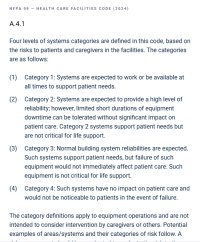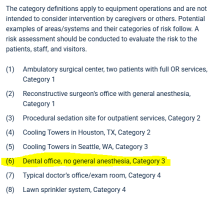Sifu
SAWHORSE
- Joined
- Sep 3, 2011
- Messages
- 3,315
2023 NEC 517 appears to have moved or removed the defined categories for patient care spaces (517.2 from the 202 NEC). If removed how are the appropriate sections like 517.18 administered, which has requirements for a category 2 space? If moved, where do I find them? The 2020 defined spaces included direct references to NFPA 99, which I assumed would tie the 99 categories to the NEC categories.
I checked what I believe to be the Health Care Governing Body, which I assume is the State Dental board and I can't find any reference to these spaces. The DP has included the requirements for a category 2 space, so is their designation enough?
I checked what I believe to be the Health Care Governing Body, which I assume is the State Dental board and I can't find any reference to these spaces. The DP has included the requirements for a category 2 space, so is their designation enough?





